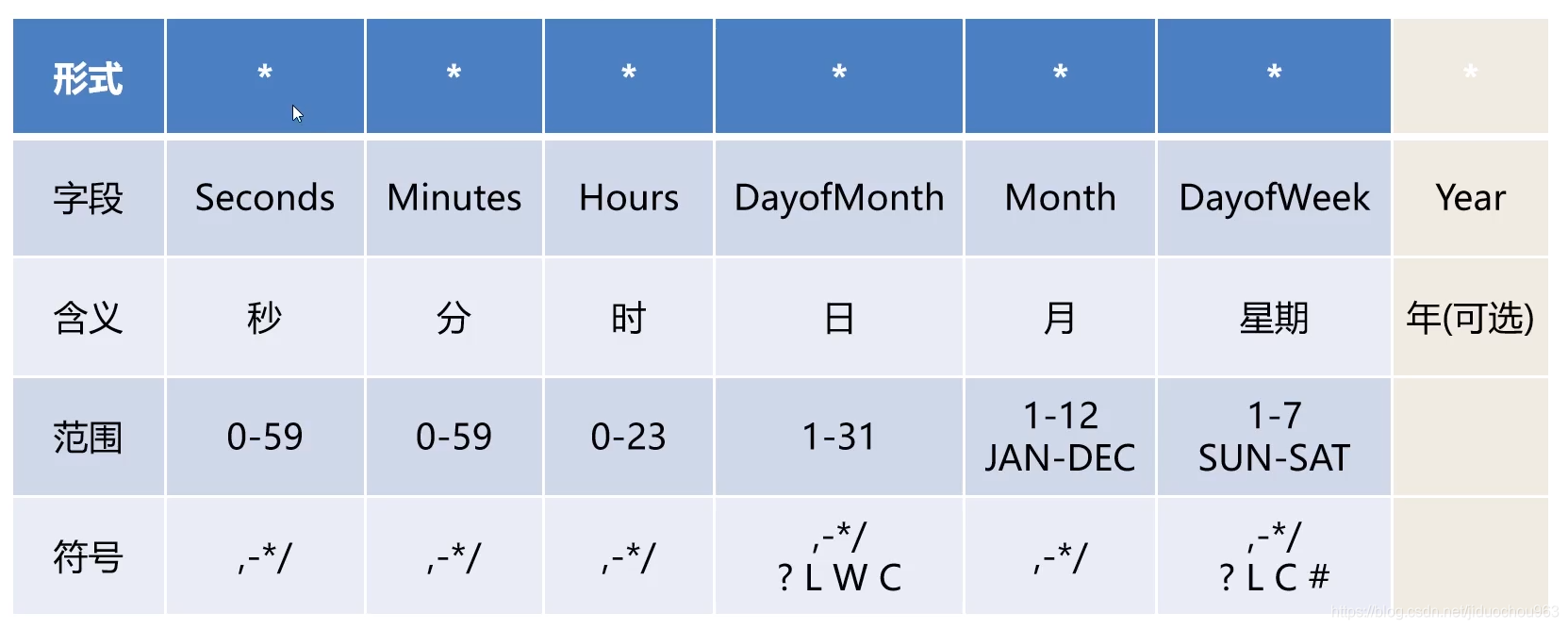Spring定时任务
两步实现定时任务
- 开启定时任务注解
- 设置执行时间
package top.onefine.schedule;
import org.springframework.boot.SpringApplication;
import org.springframework.boot.autoconfigure.SpringBootApplication;
import org.springframework.scheduling.annotation.EnableScheduling;
import org.springframework.scheduling.annotation.Scheduled;
import java.text.DateFormat;
import java.util.Date;
@EnableScheduling // 开启定时任务注解
@SpringBootApplication
public class ScheduleApplication {
public static void main(String[] args) {
SpringApplication.run(ScheduleApplication.class, args);
}
// 半小时执行一次
// @Scheduled(fixedRate = 30 * 60 * 1000) // 以毫秒为单位,启动时就会执行一次
@Scheduled(fixedRate = 3 * 1000)
public void playSomething1() {
System.out.println("执行任务1:" + DateFormat.getDateInstance().format(new Date()));
}
// 四小时执行一次
// @Scheduled(fixedRate = 4 * 60 * 60 * 1000)
@Scheduled(fixedRate = 6 * 1000)
public void playSomething12() {
System.out.println("执行任务2:" + DateFormat.getDateInstance().format(new Date()));
}
}
cron表达式
package top.onefine.schedule;
import org.springframework.boot.SpringApplication;
import org.springframework.boot.autoconfigure.SpringBootApplication;
import org.springframework.scheduling.annotation.EnableScheduling;
import org.springframework.scheduling.annotation.Scheduled;
import java.text.DateFormat;
import java.util.Date;
@EnableScheduling // 开启定时任务注解
@SpringBootApplication
public class ScheduleApplication {
public static void main(String[] args) {
SpringApplication.run(ScheduleApplication.class, args);
}
@Scheduled(cron = "0 0/30 9-22 * * ?") // 每天9点到22点每隔30分钟执行一次
public void playSomething1() {
System.out.println("执行任务1:" + DateFormat.getDateInstance().format(new Date()));
}
@Scheduled(cron = "0 0 9-22/4 * * ?") // 每天9点到22点每隔4小时执行一次
public void playSomething12() {
System.out.println("执行任务2:" + DateFormat.getDateInstance().format(new Date()));
}
}
在线生成cron表达式:https://cron.qqe2.com/

cron表达式在spring中由六个部分组成(最后一个部分不被spring支持),每个部分之间由空格分隔开来。
注
dayofweek中1表示星期天,2表示星期一…7表示星期六。

注:
以1: 5为例,分钟上5/20表示1: 5触发,1: 25触发,1: 45触发;1点就结束了!下一次从2点开始,2: 5触发,2: 25触发…

异步多线程实现
定时任务默认是单线程的定时任务,如果任务持续时间较长,就会将后续定时任务拖延,导致丢失任务。
两步实现
- 开启异步注解
- 设置异步执行
package top.onefine.schedule;
import org.springframework.boot.SpringApplication;
import org.springframework.boot.autoconfigure.SpringBootApplication;
import org.springframework.scheduling.annotation.Async;
import org.springframework.scheduling.annotation.EnableAsync;
import org.springframework.scheduling.annotation.EnableScheduling;
import org.springframework.scheduling.annotation.Scheduled;
import java.text.DateFormat;
import java.util.Date;
@EnableScheduling // 开启定时任务注解
@EnableAsync // 开启异步注解
@SpringBootApplication
public class ScheduleApplication {
public static void main(String[] args) {
SpringApplication.run(ScheduleApplication.class, args);
}
@Async // 设置异步执行
// @Scheduled(cron = "1 0 0 0 0 ?")
@Scheduled(fixedRate = 1000)
public void playSomething1() {
System.out.println(Thread.currentThread().getName() + "执行任务1:" + DateFormat.getDateInstance().format(new Date()));
}
@Async // 设置异步执行
// @Scheduled(cron = "2 0 0 0 0 ?")
@Scheduled(fixedRate = 2000)
public void playSomething12() {
System.out.println(Thread.currentThread().getName() + "执行任务2:" + DateFormat.getDateInstance().format(new Date()));
}
}

总结
